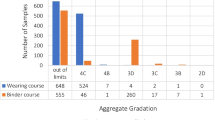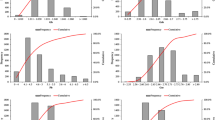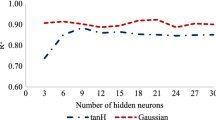Abstract
The aggregate gradation has a significant influence on the required optimum asphalt content (OAC) on the asphalt mix as the OAC is mainly responsible for coating the aggregate surface area and filling the voids in the aggregate particles. In general, laboratory tests are used for the estimation of the OAC. In Egypt, Marshall test is the most common test used for the estimation of the OAC. However, the procedures of this approach consume significant time and its results are subjected to deviations. Thus, this paper employs the multilayer perceptron feedforward neural network technique for the prediction of the OAC from the aggregate gradation for 140 asphalt mix samples. To optimize the settings and hyperparameters of the ANN, 240 different artificial neural networks (ANNs) with different number of hidden layers, different number of neurons per hidden layers, and different activation functions are tested to find the optimum ANN with the best predictions and lowest errors. Results show that the optimum ANN uses the logistic activation function and consists of four hidden layers with two neurons per layer. This optimum ANN can predict the OAC with R2 value of 0.982 when used on the testing set. Additionally, the optimum ANN was validated on three datasets from the literature to test the ability of the ANN to generalize and results show that the optimum ANN can predict the OAC with high accuracy for asphalt mixes prepared in different countries and with different properties such as the aggregate gradation, and bitumen type.







Similar content being viewed by others
Availability of data and materials
Not applicable.
Abbreviations
- OAC:
-
Optimum asphalt content
- ANN:
-
Artificial neural network
- %P(I):
-
Percentage passing from sieve i
References
The Asphalt Institute. (1988). Mix design methods for asphalt concrete and other hot-mix types. Manual Series, 2. Asphalt Institute .
Rakaraddi, P. G., & Gomarsi, V. (2015). Establishing relationship between CBR with different soil properties. International Journal of Research in Engineering and Technology, 4(2), 182–188.
Dias, J. F., Picado-Santos, L. G., & Capitão, S. D. (2014). Mechanical performance of dry process fine crumb rubber asphalt mixtures placed on the Portuguese road network. Construction and Building Materials, 73, 247–254.
Liu, Q. T., & Wu, S. P. (2014). Effects of steel wool distribution on properties of porous asphalt concrete. Key Engineering Materials, 599, 150–154.
García, A., Norambuena-Contreras, J., Bueno, M., & Partl, M. N. (2014). Influence of steel wool fibers on the mechanical, thermal, and healing properties of dense asphalt concrete. In ASTM International.
Pasandín, A. R., & Pérez, I. (2015). Overview of bituminous mixtures made with recycled concrete aggregates. Construction and Building Materials, 74, 151–161.
Zaumanis, M., Mallick, R. B., & Frank, R. (2016). 100% hot mix asphalt recycling: Challenges and benefits. Transportation Research Procedia, 14, 3493–3502.
Wang, L., Gong, H., Hou, Y., Shu, X., & Huang, B. (2017). Advances in pavement materials, design, characterisation, and simulation. Road Materials and Pavement Design, 18(sup3), 1–11.
Tapkın, S., Çevik, A., & Uşar, Ü. (2010). Prediction of Marshall test results for polypropylene modified dense bituminous mixtures using neural networks. Expert Systems with Applications, 37(6), 4660–4670.
Mousa, K. M., Abdelwahab, H. T., & Hozayen, H. A. (2021). Models for estimating optimum asphalt content from aggregate gradation. Proceedings of the Institution of Civil Engineers-Construction Materials, 174(2), 69–74.
Kandhal, P. S., & Cross, S. A. (1993). Effect of aggregate gradation on measured asphalt content. National Center for Asphalt Technology.
Ozturk, H. I., Saglik, A., Demir, B., & Gungor, A. G. (2016, June). An artificial neural network base prediction model and sensitivity analysis for Marshall mix design. In Proceedings of the 6th Eurasphalt & Eurobitume Congress, Prague, Czech Republic.
Gomaa, A. E. (2014). Marshall test results prediction using artificial neural network (Doctoral dissertation, MSc thesis, Arab Academy for Science and Technology, Cairo, Egypt).
Liu, W. F., Li, H. M., & Tian, B. P. (2011). Research on designing optimum asphalt content of asphalt mixture by calculation and experimental method. In Applied Mechanics and Materials (Vol. 97, pp. 23–27). Trans Tech Publications Ltd.
Aljassar, A. H., Ali, M. A., & Alzaabi, A. (2002). Modeling Marshall test results for optimum asphalt-concrete mix design. Kuwait Journal of Science and Engineering, 29(1), 181–195.
Baldo, N., Manthos, E., & Pasetto, M. (2018). Analysis of the mechanical behaviour of asphalt concretes using artificial neural networks. Advances in Civil Engineering. https://doi.org/10.1155/2018/1650945
Kaseko, M. S., & Ritchie, S. G. (1993). A neural network-based methodology for pavement crack detection and classification. Transportation Research Part C: Emerging Technologies, 1(4), 275–291.
Gagarin, N., Flood, I., & Albrecht, P. (1994). Computing truck attributes with artificial neural networks. Journal of Computing in Civil Engineering, 8(2), 179–200.
Cal, Y. (1995). Soil classification by neural network. Advances in Engineering Software, 22(2), 95–97.
Roberts, C. A., & Attoh-Okine, N. O. (1998). A comparative analysis of two artificial neural networks using pavement performance prediction. Computer-Aided Civil and Infrastructure Engineering, 13(5), 339–348.
Attoh-Okine, N. O. (2001). Grouping pavement condition variables for performance modeling using self-organizing maps. Computer-Aided Civil and Infrastructure Engineering, 16(2), 112–125.
Khuntia, S., Das, A. K., Mohanty, M., & Panda, M. (2014). Prediction of Marshall parameters of modified bituminous mixtures using artificial intelligence techniques. International Journal of Transportation Science and Technology, 3(3), 211–227.
Othman, K. (2021). Deep neural network models for the prediction of the aggregate base course compaction parameters. Designs, 5(4), 78.
Othman, K., & Abdelwahab, H. (2021). Prediction of the soil compaction parameters using deep neural networks. In Transportation Infrastructure Geotechnology (pp. 1–18).
Nguyen, H. L., Le, T. H., Pham, C. T., Le, T. T., Ho, L. S., Le, V. M., Pham, B. T., & Ly, H. B. (2019). Development of hybrid artificial intelligence approaches and a support vector machine algorithm for predicting the Marshall parameters of stone matrix asphalt. Applied Sciences, 9(15), 3172.
Iskender, E., Aksoy, A., Özşahin, Ş, Kahraman, H. T., & Konak, S. D. (2018). Artificial neural network-based new methodology for modeling of asphalt mixtures and comparison with IKE Method. Journal of Investigations on Engineering and Technology, 1(2), 1–13.
Fadhil, T. H., Ahmed, T. M., & Al Mashhadany, Y. I. (2021). Application of artificial neural networks as design tool for hot mix asphalt. International Journal of Pavement Research and Technology, 15, 269–283.
Azarhoosh, A. (2021). Modeling Marshall test results of hot mix asphalt using nonlinear genetic programming techniques. AUT Journal of Civil Engineering, 5(1), 11–11.
Keskin, M., & Karacasu, M. (2021). Artificial neural network modelling for asphalt concrete samples with boron waste modification. Journal of Engineering Research. https://doi.org/10.36909/jer.8124
Sebaaly, H., Varma, S., & Maina, J. W. (2018). Optimizing asphalt mix design process using artificial neural network and genetic algorithm. Construction and Building Materials, 168, 660–670.
Shah, S. A. R., Anwar, M. K., Arshad, H., Qurashi, M. A., Nisar, A., Khan, A. N., & Waseem, M. (2020). Marshall stability and flow analysis of asphalt concrete under progressive temperature conditions: An application of advance decision-making approach. Construction and Building Materials, 262, 120756.
Zhang, W., Khan, A., Huyan, J., Zhong, J., Peng, T., & Cheng, H. (2021). Predicting Marshall parameters of flexible pavement using support vector machine and genetic programming. Construction and Building Materials, 306, 124924.
Putri, H. O., Zulkifli, & Pratama, D. Y. (2021). The effect of addition plastic waste on mechanical and thermal properties of asphalt using artificial neural network. In AIP Conference Proceedings (Vol. 2384, No. 1, p. 060002). AIP Publishing LLC.
Mistry, R., & Roy, T. K. (2020). Predicting Marshall stability and flow of bituminous mix containing waste fillers by the adaptive neuro-fuzzy inference system. Revista de la Construcción, 19(2), 209–219.
Baldo, N., Manthos, E., & Miani, M. (2019). Stiffness modulus and marshall parameters of hot mix asphalts: Laboratory data modeling by artificial neural networks characterized by cross-validation. Applied Sciences, 9(17), 3502.
Azarhoosh, A., & Pouresmaeil, S. (2020). Prediction of Marshall mix design parameters in flexible pavements using genetic programming. Arabian Journal for Science and Engineering, 45(10), 8427–8441.
Le, T. H., Nguyen, H. L., Pham, C. T., Hoang, H. G. T., & Nguyen, T. A. (2022). Development of artificial neural network model for prediction of Marshall parameters of stone mastic asphalt. In CIGOS 2021, Emerging Technologies and Applications for Green Infrastructure (pp. 1795–1803). Springer, Singapore.
Upadhya, A., Thakur, M. S., Sharma, N., & Sihag, P. (2021). Assessment of soft computing-based techniques for the prediction of marshall stability of asphalt concrete reinforced with glass fiber. International Journal of Pavement Research and Technology. https://doi.org/10.1007/s42947-021-00094-2
Androjić, I., & Marović, I. (2017). Development of artificial neural network and multiple linear regression models in the prediction process of the hot mix asphalt properties. Canadian Journal of Civil Engineering, 44(12), 994–1004.
Sangsefidi, E., Ziari, H., & Sangsefidi, M. (2016). The effect of aggregate gradation limits consideration on performance properties and mixture design parameters of hot mix asphalt. KSCE Journal of Civil Engineering, 20(1), 385–392.
Afaf, A. H. M. (2014). Effect of aggregate gradation and type on hot asphalt concrete mix properties. Journal of Engineering Sciences, 42(3), 567–574.
Ridolfi, D. V. (1998). Effect of aggregate gradation on performance characteristics of hot mix asphalt. University of Nevada.
Ahlrich, R. C. (1996). Influence of aggregate gradation and particle shape/texture on permanent deformation of hot mix asphalt pavements. Army Engineer Waterways Experiment Station Vicksburg MS Geotechnical Lab.
Button, J. W., Perdomo, D., & Lytton, R. L. (1990). Influence of aggregate on rutting in asphalt concrete pavements. Transportation Research Record, 1259, 141–152.
Stakston, A. D., & Bahia, H. U. (2003). The effect of fine aggregate angularity, asphalt content and performance graded asphalts on hot mix asphalt performance (Vol. 92, No. 45–98). Wisconsin Highway Research Program.
Bissada, A. F. (1984). Resistance to compaction of asphalt paving mixtures and its relationship to stiffness. ASTM International.
El-Basyouny, M., & Mamlouk, M. S. (1999, January). Effect of aggregate gradation on the rutting potential of Superpave mixes. In 78th Annual Meeting of the Transportation Research Board. Washington, DC.
Othman, K. M. M., & Abdelwahab, H. (2021). Prediction of the optimum asphalt content using artificial neural networks. Metallurgical and Materials Engineering, 27(2), 227–242.
ECP (Egyptian Code Provisions) ECP (104/4). (2008). Egyptian code for urban and rural roads. Part (4): road material and its tests. Housing and Building National Research Center, Cairo, Egypt (2008)
Othman, K. (2021). Evaluation of the hot asphalt mix aggregate gradation using Bailey method: A state-of-the-art. JES. Journal of Engineering Sciences, 49(4), 446–475.
Highway Technical Specifications (2006). General Directorate of Highways, Item No. 170/2, Ankara, Turkey.
Haykin, S. (1999). Neural networks: a comprehensive foundation. 1999. Mc Millan, New Jersey, 1–24.
Goodfellow, I., Bengio, Y., & Courville, A. (2017). Deep learning (adaptive computation and machine learning series). Cambridge Massachusetts (pp. 321–359).
Bishop, C. M., & Nasrabadi, N. M. (2006). Pattern recognition and machine learning (Vol. 4, No. 4, p. 738). Springer.
Prechelt, L. (1998). Early stopping-but when?. In Neural networks: Tricks of the trade (pp. 55–69). Springer.
Hussain, F., Ali, Y., & Irfan, M. (2021). Quantifying the differential phase angle behaviour of asphalt concrete mixtures using artificial neural networks. International Journal of Pavement Research and Technology. https://doi.org/10.1007/s42947-021-00042-0
Acknowledgements
Not applicable.
Funding
Not applicable.
Author information
Authors and Affiliations
Contributions
(KO) literature search and review, research methodology, data preparation, data analysis, manuscript writing and reviewing.
Corresponding author
Ethics declarations
Conflict of interests
The authors declare that they have no competing interests.
Ethics approval and consent to participate
Not applicable
Consent for publication
Not applicable.
Rights and permissions
About this article
Cite this article
Othman, K. Artificial Neural Network Models for the Estimation of the Optimum Asphalt Content of Asphalt Mixtures. Int. J. Pavement Res. Technol. 16, 1059–1071 (2023). https://doi.org/10.1007/s42947-022-00179-6
Received:
Revised:
Accepted:
Published:
Issue Date:
DOI: https://doi.org/10.1007/s42947-022-00179-6




